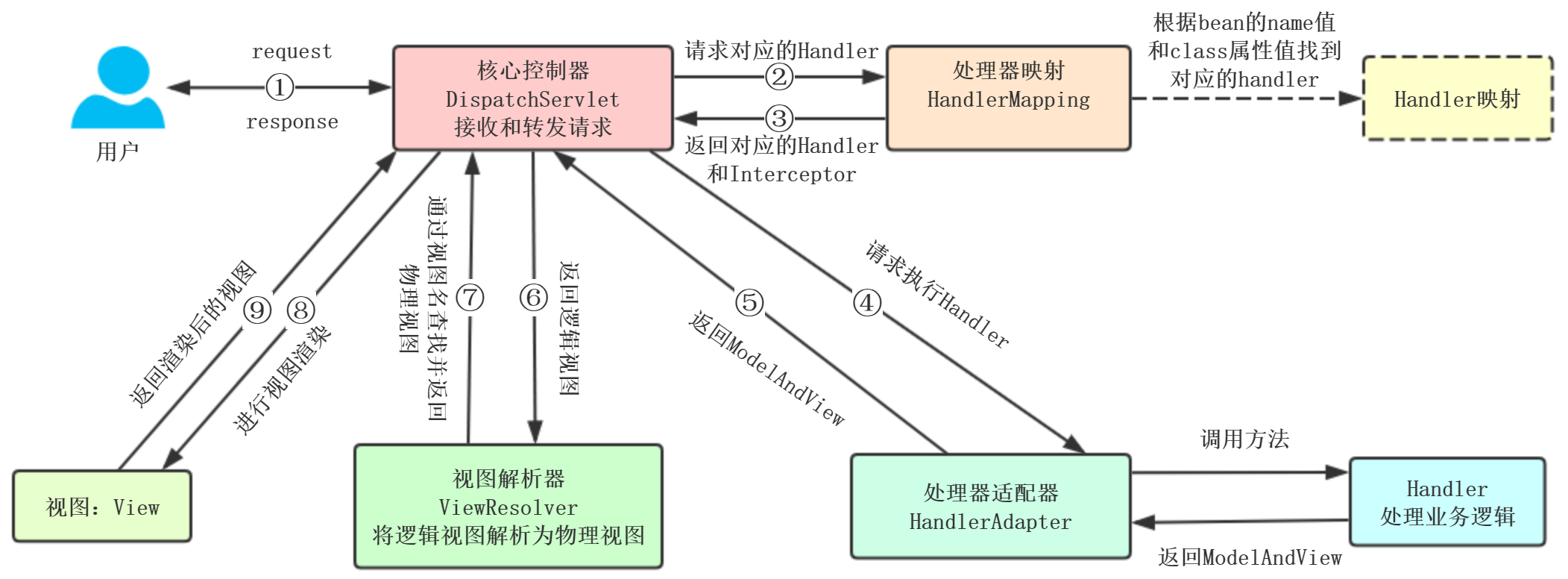Web项目开发过程中一般都是使用MVC(Model-View-Controller)模式,早先的Struts2到Spring MVC,再到现在Spring Boot,都是相似的思
路。Spring Boot用多了就真的不想回到SSM或者SSH框架(虽然公司还在用Spring MVC),写这篇随笔,算是自己对Spring MVC内容的复习吧。
工作流程

DispatchServlet的配置方式
1、web.xml
2、通过将其配置在Servlet容器中(Tomcat7+版本要求)

/** * AbstractAnnotationConfigDispatcherServletInitializer的拓展类会自动配置DispatchServlet和 * Spring ApplicationContext(应用上下文位于应用程序的Servlet上下文之中) */ public class SpittrWebAppInitializer extends AbstractAnnotationConfigDispatcherServletInitializer { /** * 返回带有@Configuration注解的类用来定义ContextLoaderListener创建的应用上下文中的bean * @return */ @Override protected Class<?>[] getRootConfigClasses() { return new Class[]{RootConfig.class}; } /** * 返回带有@Configuration注解的类用来定义DispatchServlet创建的应用上下文中的bean * @return */ @Override protected Class<?>[] getServletConfigClasses() { return new Class[]{WebConfig.class}; } /** * 将一个或多个路径映射到DispatchServlet上。"/"表示使用应用默认的Servlet,会理所有请求 * @return */ @Override protected String[] getServletMappings() { return new String[] {"/"}; } }

public class WebConfig extends WebMvcConfigurerAdapter{ //通常包含视图解析器配置 //静态资源处理 //。。。。。 }
DispatchServlet启动的时候,会创建Spring应用上下文,加载声明的bean,Spring Web应用中,通常还有另一个应用上下文,由
ContextLoaderListener创建
DispatchServlet:加载包含Web组件的bean,如控制器、视图解析器、处理器映射
ContextLoaderListener:加载应用中的其他bean,通常是驱动应用后端的中间层和数据层组件
常用注解
以下URL测试都是使用restlet client,也可以使用postman等工具
1、@EnableWebMvc:在配置类中开启Web MVC的配置支持,如一些ViewResolver或者MessageConverter等,不使用注解,需要重写
WebMvcConfigurerAdapter方法用于对SpringMVC的配置。
2、@RequestParam:
参数:name、value、defaultValue、required
分别代表:参数名、值、默认值(如果没有这个参数,给默认值),参数必须有,否则400错误(如果有defaultValue就不会有问题)
请求URL:http://localhost:8080/test5?id=1001&name&sex1=1
@RequestMapping(value = "/test5", method = RequestMethod.GET) public String test5(@RequestParam int id, @RequestParam(value = "name", defaultValue = "zhangsan", required = true) String name) { System.out.println("test2 id: " + id + " name: " + name ); return "index"; }
test2 id: 1001 name: zhangsan
name和value没有区别,value别名是name,name别名是value
public @interface RequestParam { @AliasFor("name") String value() default ""; @AliasFor("value") String name() default ""; boolean required() default true; String defaultValue() default " ue000ue001ue002 "; }
如果参数名一致,可以选择不使用@RequestParam
URL:localhost:8080/test?name=sam
public String test(HttpServletRequest request, String name, ModelMap modelMap) { modelMap.put("name", "sam"); log.info("param is {}", name); return "home"; }
PS:我们使用@RequestParam只是因为能够提供name,required、defaultValue属性,否则可以选择不使用
3、@RequestMapping:
包含参数:value、method、params、headers、consumes、produces
1).直接使用默认:http://host:port/path?id=1001
@RequestMapping("test1")
public String test1(@RequestParam("id") String id) {
System.out.println("test1 id: " + id);
return "index";
}
test1 id: 1001
2).value、method:
value:指定请求的实际地址,或者使用URI Template模式
method:请求的方法类型,支持以下类型,可选择多种
public enum RequestMethod { GET, HEAD, POST, PUT, PATCH, DELETE, OPTIONS, TRACE; private RequestMethod() { } }
@ResponseBody @RequestMapping(value = "/test1", method = RequestMethod.GET) // @RequestMapping(value = "/test1", method = {RequestMethod.GET, RequestMethod.POST}) public String test1(@RequestParam("id") String id) { System.out.println("test1 id: " + id); return "index"; }
3).params、headers:
params: 指定request中必须包含某些参数值才能进入方法
headers: 指定request中必须包含某些指定的header值才能进入方法
@ResponseBody @RequestMapping(value = "/test3", method = RequestMethod.GET, params = {"id=1001", "name", "!sex"}, headers = {"Accept"})
public String test3(@RequestParam int id, @RequestParam("name") String name, @RequestParam("abc") String addr) {
System.out.println("test2 id: " + id + " name: " + name + " addr: " + addr);
return "index";
}
params={"id=1001", "name", "!sex"}表示参数中,id必须为1001,必须包含name,不能包含sex,否则返回400 Bad Request状态码
headers = {"Accept"}表示请求头包含accept信息
4).consumes、produces
@RequestMapping(value = "/test1", method = RequestMethod.GET, params = {"!id", "name", "!sex"}
, headers = {"Accept"}, consumes = MediaType.APPLICATION_JSON_VALUE, produces = MediaType.APPLICATION_JSON_UTF8_VALUE)
@ResponseBody
public String test1(HttpServletRequest request, @RequestParam(value = "name", required = false) String name, ModelMap modelMap) {
modelMap.put("name", "sam");
log.info("param is {}", name);
return name;
}
consumes = MediaType.APPLICATION_JSON_VALUE表示request的content-type必须为application/json
produces = MediaType.APPLICATION_JSON_UTF8_VALUE表示response的content-type为application/json,编码为utf-8
4、@PathVariable:
参数:name、value、required,没有了defaultValue
请求URL:http://localhost:8080/test2/id/1001/name/sam
@ResponseBody @RequestMapping(value = "/test2/id/{id}/name/{name}", method = RequestMethod.GET) public String test4(@PathVariable("id") int id, @PathVariable("name") String name) { System.out.println("test2 id: " + id + " name: " + name); return "index"; }
test2 id: 1001 name: sam
到此时:我们可以看到@PathVariable和@RequestParam的区别


@PathVariable会把URL template变量映射到参数中,而@RequestParam中相当于request.getParameter("name"),去获取请求中的参数
5、表单验证@Valid:都在javax.validation.constraints包里面
public class Login { @NotNull @IsMobile private String mobile; @NotNull @Length(min=32) private String password; }
public Result<String> doLogin(HttpServletResponse response, @Valid LoginVo loginVo) { log.info(loginVo.toString()); //登录 String token = userService.login(response, loginVo); return Result.success(token); }
6、@ResponseBody:支持将返回值放在response内,而不是一个页面,通常用户返回json/xml数据
@ResponseBody public String test3() { return "id";//这时候返回到页面的是String,而不是解析到id.html等类似的页面 }
6、@RequestBody:允许request的参数在request体中,而不是在直接连接在地址后面。例如通过ajax传递的json参数

@RequestMapping(value = "/test1", method = RequestMethod.GET, params = {"!id", "name", "!sex"}
, headers = {"Accept"}, consumes = MediaType.APPLICATION_JSON_VALUE, produces = MediaType.APPLICATION_JSON_UTF8_VALUE)
@ResponseBody
public String test1(HttpServletRequest request, @RequestBody String addr, @RequestParam(value = "name", required = false) String name, ModelMap modelMap) {
modelMap.put("name", "sam");
log.info("param is {} and {}", name, addr);
return name;
}
通过@RequestBody才能在get请求中得到Body中的参数,因为get请求默认只能读取URL中的参数
7、@RestController:相当于@Controller和@ResponseBody的组合,注解在类上,该Controller的所有方法都默认加上了@ResponseBody。
@Controller @ResponseBody public @interface RestController { String value() default ""; }
9、@RequestHeader:把Request请求header部分的值绑定到方法的参数上
请求URL:http://localhost:8080/test6
@ResponseBody @RequestMapping(value = "/test6", method = RequestMethod.GET) public String test6(@RequestHeader("Accept-Encoding") String encoding) { System.out.println("test2 contentType: " + encoding + " date: " ); return "index"; }
test2 contentType: gzip, deflate, br date:
10、@CookieValue

@ResponseBody @RequestMapping(value = "/test7", method = RequestMethod.GET) public String test7(@CookieValue("JSESSIONID") String cookie) { System.out.println("test2 cookie: " + cookie + " date: " ); return "index"; }
test2 cookie: 3E3E78E5E977EDBAEA388D8829BA2764
视图解析器
Spring自带13个视图解析器,常用的有:
InternalResourceViewResolver:一般用于JSP,在视图名称上面添加前缀和后缀,进而确定页面的物理地址,Prefix和suffix
FreeMarkerViewResolver和VelocityViewResolver分别对应FreeMaker和Velocity模板视图
